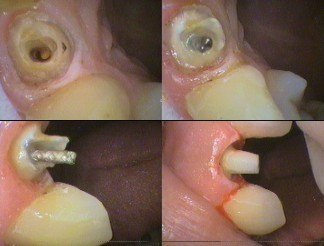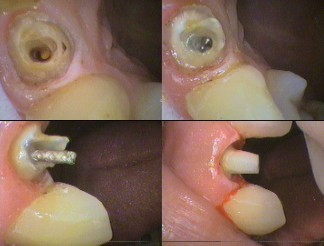
Once a dental crown is placed, it can be removed and replaced. Attempting to do so with force risks damaging both the crown and the underlying tooth structure. Dental crowns are custom-made for each tooth and are not interchangeable. If replacement is necessary, a new crown must be created specifically for that tooth. While reusing a crown may seem cost-effective, it is not a viable option due to the potential for damage and the need for custom fitting. It’s essential to consult with a dentist for proper guidance on crown removal and replacement procedures.

Can Dental Crowns Be Removed and Reused?
Dental crowns are common dental restorations used to cover and protect damaged or weakened teeth. However, there may be instances where a dental crown needs to be removed and potentially reused. In this article, we will explore whether dental crowns can be removed and reused, and discuss the factors that determine their reusability.
Reasons for Removing Dental Crowns
There are several reasons why a dental crown may need to be removed.
- One common reason is when the crown becomes loose or unstable. This can occur due to issues with the underlying tooth structure, such as decay or damage.
- The crown may need to be removed to address these underlying issues before a new crown can be placed.
- Another reason for crown removal is when the crown itself becomes damaged or fractured. This can happen due to trauma, biting on hard objects, or normal wear and tear over time. In such cases, the crown may need to be replaced with a new one to ensure proper function and aesthetics.
Can Dental Crowns Be Reused?
The reusability of a dental crown depends on several factors. One of the main factors is the condition of the crown itself. If the crown is in good condition, without any visible damage or wear, it may be possible to remove and reuse it. However, the decision to reuse a crown ultimately lies with the dentist, who will assess its viability based on various factors.
The condition of the underlying tooth is another important consideration. If the tooth structure is compromised or if there are any changes to the tooth since the crown was initially placed, it may not be possible to reuse the crown. The dentist will need to evaluate the tooth’s health and determine if a new crown is necessary.
Factors Affecting Reusability
Several factors can affect the reusability of a dental crown. These include:
1. Fit: The crown must fit securely and snugly onto the tooth for it to be reusable. If the fit is compromised or if the crown has undergone significant wear and tear, it may not be suitable for reuse.
2. Material: The type of material used for the crown can also impact its reusability. Some materials, such as porcelain or zirconia, may be more prone to damage and wear over time, making them less likely to be reusable.
3. Age: The age of the crown can also be a determining factor. Older crowns may have undergone more wear and tear, making them less likely to be suitable for reuse.
4. Oral health: The overall oral health of the patient plays a significant role in the decision to reuse a crown. If there are underlying issues with the tooth or surrounding structures, it may be necessary to replace the crown to ensure optimal oral health.
Benefits of Reusing Dental Crowns
There are a few potential benefits to reusing dental crowns.
- Firstly, reusing a crown can save time and cost for the patient. Instead of creating a new crown from scratch, the dentist can simply remove the existing crown and reattach it if it is still in good condition.
- Additionally, reusing a crown eliminates the need for additional dental procedures, such as taking impressions and fabricating a new crown. This can be especially beneficial for patients who may have anxiety or discomfort associated with dental procedures.
However, it’s important to note that the decision to reuse a crown should be made on a case-by-case basis, taking into consideration the specific circumstances and the dentist’s professional judgment.
Alternatives to Reusing Dental Crowns
In cases where a dental crown cannot be reused, there are alternative options available. One option is to create a new crown using the same materials and specifications as the original crown. This ensures a proper fit and aesthetics while addressing any underlying issues with the tooth.
Another alternative is to explore different restorative options, such as dental implants or bridges. These alternatives may be recommended if the underlying tooth structure is severely compromised or if there are concerns about the long-term viability of reusing the crown.
Conclusion
In conclusion, the reusability of dental crowns depends on several factors, including the condition of the crown, the health of the underlying tooth, and the dentist’s professional judgment. While reusing a crown can have its benefits, it is essential to prioritize the patient’s oral health and ensure the most appropriate treatment option is chosen. If you have any concerns about your dental crown, it is best to consult with your dentist for personalized advice and recommendations.
Key Takeaways: Can Dental Crowns Be Removed and Reused?
- Dental crowns are designed to be permanent and are not typically removed and reused.
- Removing a crown can damage it and compromise its fit and function.
- Reusing a crown may not provide the same level of fit and aesthetics as a new crown.
- If a crown needs to be replaced, it is usually recommended to get a new custom-made crown.
- Dental professionals can evaluate each case individually to determine the best course of action.
Frequently Asked Questions
Can dental crowns be removed and reused?
While dental crowns can technically be removed, it is not common practice to reuse them. When a crown is placed on a tooth, it is shaped and customized to fit that particular tooth perfectly. Removing the crown can cause damage to both the crown itself and the underlying tooth structure. Additionally, the bonding materials used to attach the crown may not hold up to the removal process, making it difficult to reuse the crown effectively.
Furthermore, dental crowns are usually made of materials that are not designed to be reused. Porcelain or ceramic crowns, for example, may become damaged or weakened during the removal process, making them unsuitable for reuse. It is generally recommended to replace a crown with a new one if it needs to be removed, as this ensures the best fit and longevity for the tooth.
How are dental crowns typically removed?
Removing a dental crown typically involves a dental professional using specialized tools and techniques. The first step is to numb the area with local anesthesia to ensure a comfortable experience for the patient. Then, the dentist will carefully cut and remove the crown using dental burs and other precision instruments.
After the crown is removed, any remaining cement or adhesive is cleaned off the tooth. The tooth is then evaluated to determine if any further treatment or restoration is necessary. In some cases, a new crown may be placed immediately, while in others, additional procedures such as root canal therapy or build-up may be needed before a new crown can be placed.
Are there any risks associated with removing a dental crown?
While removing a dental crown is generally a safe procedure when performed by a qualified dental professional, there are some risks to be aware of. The removal process can potentially cause damage to the underlying tooth structure or surrounding gums. In rare cases, the crown itself may fracture or break during removal.
It is important to choose a skilled and experienced dentist to perform the crown removal to minimize these risks. They will take necessary precautions and use proper techniques to ensure the best outcome. Regular dental check-ups and maintaining good oral hygiene can also help prevent the need for crown removal in the first place.
Can a dental crown be reused if it is in good condition?
While it is technically possible to reuse a dental crown if it is in good condition, it is not a common practice. As mentioned earlier, dental crowns are custom-made to fit a specific tooth and removing them can cause damage to both the crown and the tooth structure.
Additionally, advancements in dental technology have led to the development of newer and more durable materials for dental crowns. These materials provide better aesthetics and longevity compared to older crowns. Therefore, it is generally recommended to replace a crown with a new one rather than attempting to reuse it, even if it appears to be in good condition.
What are the alternatives to reusing a dental crown?
If a dental crown needs to be removed, there are several alternatives to reusing it. One option is to have a new crown made to replace the old one. This ensures a proper fit and allows for any necessary improvements in aesthetics or functionality.
In some cases, a dental bridge or implant may be recommended as an alternative to a crown. A bridge involves placing crowns on adjacent teeth to support a prosthetic tooth, while an implant involves surgically placing an artificial tooth root in the jawbone and attaching a crown to it. These options provide long-term solutions for missing or damaged teeth.
How long dental crowns last and how often they need to be replaced
Final Thoughts
While it’s technically feasible to remove and reuse dental crowns, it’s uncommon due to potential compromises in integrity and effectiveness. Dentists advise replacing crowns rather than reusing them, ensuring optimal protection and restoration. Consultation with a dental professional is crucial for personalized recommendations based on individual circumstances. Trusting their expertise ensures the most effective treatment.
Call or Book appointment online
:Ace Dental Care Alpharetta office: 678-562-1555 - Book Now
Ace Dental Care Norcross office: 770-806-1255 - Book Now
Disclaimer
This blog post was generated by artificial intelligence. The content of this post may not be accurate or complete, and should not be relied upon as a substitute for professional advice. If you have any questions about the content of this post, please contact us.
We are constantly working to improve the accuracy and quality of our AI-generated content. However, there may still be errors or inaccuracies. We apologize for any inconvenience this may cause.





